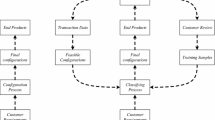Abstract
With the context of individualized product design in mass customization, the practice of product configuration is transformed from traditional unidirectional process into bidirectional design interactions. In this interactive configuration manner, maintaining the consistency of configuration assignments, often referred to as consistency restoration, is one of the primary issues which should be addressed. The task of consistency restoration faces two great challenges: the uncertainty and individualized flexibility of customer requirements. The uncertainty turns problem dynamic and deteriorates the computational complexity of existing consistency restoration methods. The individualized flexibility turns the task of consistency restoration ill-structured. Consequently, these two characteristics increase the response time in interactive configuration and make companies face the challenge of ‘customization-responsiveness squeeze’. To leverage this problem, this paper proposes a responsive approach to facilitate the task of consistency restoration. A methodology based on content-addressable memory (CAM) is established, which compiles a CSP-based consistency restoration into a memory recalling process and automatically corrects the incompleteness and inconsistency within the memory. Specific orientation mechanism based on customer preference is proposed to introduce customer flexibility into CAM model. The resulting oriented-CAM method is demonstrated by a case study and the performance and responsiveness are analyzed.
Similar content being viewed by others
Explore related subjects
Discover the latest articles and news from researchers in related subjects, suggested using machine learning.References
Aldanondo M., Hadj-Hamou K., Moynard G., Lamothe J. (2003) Mass customization and configuration: Requirement analysis and constraint based modeling propositions. Integrated Computer-Aided Engineering 10(2): 177–189
Amilhastre J., Fargier H., Marquis P. (2002) Consistency restoration and explanations in dynamic CSPs-Application to configuration. Artificial Intelligence 135(1–2): 199–234 doi:10.1016/S0004-3702(01)00162-X
Apt K.R. (2003) Principles of constraint programming. Cambridge University Press, Cambridge
Babloyantz A., Lourenco C. (1996) Brain chaos and computation. International. Journal of Neural Systems 7(4): 461–471 doi:10.1142/S0129065796000440
Bersini H. (1998) The frustrated and compositional nature of chaos in small Hopfield networks. Neural Networks 11(6): 1017–1025 doi:10.1016/S0893-6080(98)00056-2
Bohland J.W., Minai A.A. (2001) Efficient associative memory using small-world architecture. Neurocomputing 38–40: 489–496 doi:10.1016/S0925-2312(01)00378-2
Chen S.L., Tseng M.M. (2005) Defining specifications for custom products: A multi-attribute negotiation approach. CIRP Annals-Manufacturing Technology 54(1): 159–162 doi:10.1016/S0007-8506(07)60073-0
Chen, S. L., & Tseng, M. M. (2006). Turning a configurator into a bargaining table. Proceedings of the ECAI 2006, Workshop on Configuration, Affiliated with the 17th European Conference on Artificial Intelligence, 2006.
Christian, B. (1991). Arc-consistency for dynamic constraint satisfaction problems (pp. 221–227). Proceedings of the AAAI-91 Conference.
Christian B. (1992) Arc-consistency for non-binary dynamic CSPs. Proceedings of ECAI 92: 23–27
Dahan, E., & Hauser, J. (2002). Product development: Managing a dispersed process. In B. A. Weitz & R. Wensley (Eds.), Handbook of marketing (pp.179–223). London, Thousand Oaks: SAGE.
Darlington M.J., Culley S.J. (2002) Current research in the engineering design requirement. Proceedings of the Institution of Mechanical Engineers 216(3): 375–388 doi:10.1243/0954405021520049
Floreen, P., & Orponen, P. (1994). Complexity issues in discrete hopfield networks (pp. 54.) Report A-1994-4, Univ. of Helsinki, Dept. of Computer Science.
Golden, M., Siemens, R., & Ferguson, J. (1986). What’s wrong with rules? (pp. 162–165) Proc. WESTEX-86, IEEE Computer Society Press, Los Alamitos, Ca.
Hagan M.T., Demuth H.B., Beale M. (1996) Neural network design. PWS Publishing Company, USA
Hagiwara M. (1990) Multi-directional associative memory (MAM). Proceeding of International Joint Conference of Neural Networks 1: 3–6
Hopfield J.J. (1982) Neural networks and physical systems with emergent collective computational abilities. Proceedings of the National Academy of Sciences of the United States of America 79: 2554–2558 doi:10.1073/pnas.79.8.2554
Hopfield, J. J. (1984). Neurons with graded response have collective computational properties like those of two-state neurons. Proceedings of the National Academy of Sciences of the United States of America 3088–3092. doi:10.1073/pnas.81.10.3088
Hopfield J.J., Tank D.W. (1985) Neural computation of decisions in optimization problems. Biological Cybernetics 52: 141–154
Jiao, J. X., Simpson, T. W., & Siddique, Z. (2006). Product family design and platform-based product development: A state-of-the-are review. Journal of Intelligent Manufacturing, 17(1).
Kosko B. (1988) Bidirectional associative memories. IEEE Transactions on Systems Man, and Cybernetics 18(1): 49–60 doi:10.1109/21.87054
Li J.H., Michel A.N., Porod W. (1989) Analysis and synthesis of a class of neural networks: Linear systems operating on a closed hypercube. IEEE Transactions on Circuits and Systems 36(11): 1405–1422 doi:10.1109/31.41297
Mannisto, T., Peltonen, H., & Sulonen, R. (1996). View to product configuration knowledge modeling and evolution. Technical report FS-96-03, Workshop on configuration, AAAI Press, 111–118.
McCutcheon D.M., Raturi A.S., Meredith J.R. (1994) The Customization-responsiveness squeeze. Sloan Management Review 35(2): 89–99
Mittal, S., & Frayman, F. (1989). Towards a generic model of configuration task (pp. 1395–1401). Proceeding of 11th International Joint Conference of Artificial Intelligence, Morgan Kaufmann, San Francisco.
Narodytska, N., & Walsh, T. (2006). Constraint and variable ordering heuristics for compiling configuration problems (pp. 2–7). Proceeding of the 17th European Conference Artificial Intelligence, Workshop on Configuration, Riva del Garda, Italy.
Nemoto I., Kubono M. (1996) Complex associative memory. Neural Networks 9(2): 253–261 doi:10.1016/0893-6080(95)00004-6
Sabin D., Weigel R. (1998) Product configuration frameworks-a survey. IEEE Intelligent Systems & Their Applications 13(4): 42–49
Salvador F., Forza C. (2004) Configuring products to address the customization-responsiveness squeeze: A survey of management issues and opportunities. International Journal of Production Economics 91(3): 273–291 doi:10.1016/j.ijpe.2003.09.003
Schiex, T., Fargier, H., & Verfaillie, G. (1995). Valued constraint satisfaction problems: Hard and easy problems. Proceedings of the International Joint Conference in AI, Montreal, Canada.
Suh N.P. (1990) The principles of design. Oxford University Press, New York,NY
Tank D.W., Hopfield J.J. (1986) Simple neural optimization networks: An A/D converter, signal decision circuit and a linear programming circuit. IEEE Transactions on Circuits and Systems 33(5): 533–541 doi:10.1109/TCS.1986.1085953
Wiggins S. (1990) Introduction to applied nonlinear dynamical systems and chaos. Springer, New York
Yamada T., Amemiya Y. (1999) A multiple-valued Hopfield network device using single-electron circuits. IEICE Transactions on Electronics, E (Norwalk, Conn.) 82 C-(9): 1615–1622
Author information
Authors and Affiliations
Corresponding author
Rights and permissions
About this article
Cite this article
Chen, Z., Wang, L. Responsive consistency restoration in interactive product configuration by content-addressable memory. J Intell Manuf 20, 463–479 (2009). https://doi.org/10.1007/s10845-008-0149-6
Received:
Accepted:
Published:
Issue Date:
DOI: https://doi.org/10.1007/s10845-008-0149-6




